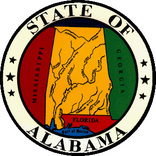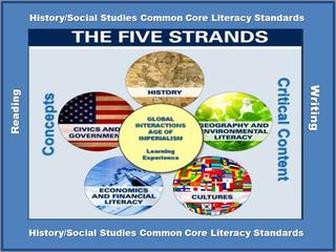STATE STANDARDS FOR SIXTH GRADE SOCIAL STUDIES
The standards for the state of Alabama for sixth grade social studies define what is required for students to learn in sixth grade social studies by the end of the year. In order to meet these standards, every lesson is structured with lesson objectives and outcomes. Objectives are the content and skills the teacher will teach the students in order to achieve the Alabama State Standards. Outcomes are the specific abilities the student will be able to perform as evidence that they mastered the teacher's objectives and achieved the required state standard.
AL Social Studies Course of Study for 6th Grade:
Below is the Alabama Social Studies Course of Study for 6th Grade. To see which standards are covered in each unit, topic, or lesson, simply click on the page from the standards pull down menu at the top of the page or click on the link under the Table of Contents below the AL Course of Study.
|
Students will:
1. Explain the impact of industrialization, urbanization, communication, and cultural changes on life in the
United States from the late nineteenth century to World War I.
2. Describe reform movements and changing social conditions during the Progressive Era in the United
States.
3. Identify causes and consequences of World War I and reasons for the United States’ entry into the war -
Sinking of the Lusitania, Zimmerman Note, alliances, militarism, imperialism, and nationalism.
4. Identify cultural and economic developments in the United States from 1900 through the 1930s.
5. Explain causes and effects of the Great Depression on the people of the United States. - Examples:
economic failure, loss of farms, rising unemployment, building of Hoovervilles
6. Identify causes and consequences of World War II and reasons for the United States’ entry into the war
7. Identify changes on the American home front during World War II. - Example: rationing
8. Describe how the United States’ role in the Cold War influenced domestic and international events
9. Critique major social and cultural changes in the United States since World War II.
10. Analyze changing economic priorities and cycles of economic expansion and contraction for their impact
on society since World War II - Examples: shift from manufacturing to service economy, higher standard
of living, globalization, outsourcing, insourcing, “boom and bust,” economic bubbles.
11. Identify technological advancements on society in the United States since World War II. - Examples:
12. Evaluate significant political issues and policies of presidential administrations since World War II.
1. Explain the impact of industrialization, urbanization, communication, and cultural changes on life in the
United States from the late nineteenth century to World War I.
2. Describe reform movements and changing social conditions during the Progressive Era in the United
States.
- Relating countries of origin and experiences of new immigrants to life in the United States - Ellis Island and Angel Island experiences
- Identifying workplace reforms, including the eight-hour workday, child labor laws, and workers’ compensation laws
- Identifying political reforms of Progressive movement leaders, including Theodore Roosevelt and the establishment of the national park system
- Identifying social reforms of the Progressive movement, including efforts by Jane Adams, Clara Barton, and Julia Tutwiler
- Recognizing goals of the early civil rights movement and the purpose of the National Association for the Advancement of Colored People (NAACP)
- Explaining Progressive movement provisions of the Sixteenth, Seventeenth, Eighteenth, Nineteenth, and Twenty-first Amendments to the Constitution of the United States
3. Identify causes and consequences of World War I and reasons for the United States’ entry into the war -
Sinking of the Lusitania, Zimmerman Note, alliances, militarism, imperialism, and nationalism.
- Describing military and civilian roles in the United States during World War I
- Explaining roles of important persons associated with World War I, including Woodrow Wilson and Archduke Franz Ferdinand
- Analyzing technological advances of the World War I era for their impact on modern warfare - Examples: machine gun, tank, submarine, airplane, poisonous gas, gas mask
- Locating on a map major countries involved in World War I and boundary changes after the war
- Explaining the intensification of isolationism in the United States after World War I - Example: reaction of the Congress of the United States to the Treaty of Versailles, League of Nations, and Red Scare
- Recognizing the strategic placement of military bases in Alabama
4. Identify cultural and economic developments in the United States from 1900 through the 1930s.
- Describing the impact of various writers, musicians, and artists on American culture during the Harlem Renaissance and the Jazz Age - Examples: Langston Hughes, Louis Armstrong, Ernest Hemingway, F. Scott Fitzgerald, Andrew Wyeth, Frederic Remington, W. C. Handy, Erskine Hawkins, George Gershwin, Zora Neale Hurston
- Identifying contributions of turn-of-the-century inventors - Examples: George Washington Carver, Henry Ford, Alexander Graham Bell, Thomas Alva Edison, Wilbur and Orville Wright
- Describing the emergence of the modern woman during the early 1900s - Examples: Amelia Earhart, Zelda Fitzgerald, Helen Keller, Susan B. Anthony, Margaret Washington, suffragettes, suffragists, flappers
- Identifying notable persons of the early 1900s - Examples: Babe Ruth, Charles A. Lindbergh, W. E. B. Du Bois, John T. Scopes
- Comparing results of the economic policies of the Warren G. Harding, Calvin Coolidge, and Herbert Hoover Administrations - Examples: higher wages, increase in consumer goods, collapse of farm economy, extension of personal credit, stock market crash, Immigration Act of 1924
5. Explain causes and effects of the Great Depression on the people of the United States. - Examples:
economic failure, loss of farms, rising unemployment, building of Hoovervilles
- Identifying patterns of migration during the Great Depression
- Locating on a map the area of the United States known as the Dust Bowl
- Describing the importance of the election of Franklin D. Roosevelt as President of the United States, including the New Deal alphabet agencies
- Locating on a map the river systems utilized by the Tennessee Valley Authority (TVA)
6. Identify causes and consequences of World War II and reasons for the United States’ entry into the war
- Locating on a map Allied countries and Axis Powers
- Locating on a map key engagements of World War II, including Pearl Harbor; the battles of Normandy, Stalingrad, and Midway; and the Battle of the Bulge
- Identifying key figures of World War II, including Franklin D. Roosevelt, Sir Winston Churchill, Harry S. Truman, Joseph Stalin, Adolf Hitler, Benito Mussolini, Michinomiya Hirohito, and Hideki Tōjō
- Describing the development of and the decision to use the atomic bomb
- Describing human costs associated with World War II - Examples: the Holocaust, civilian and military casualties
- Explaining the importance of the surrender of the Axis Powers ending World War II
7. Identify changes on the American home front during World War II. - Example: rationing
- Recognizing the retooling of factories from consumer to military production
- Identifying new roles of women and African Americans in the workforce
- Describing increased demand on the Birmingham steel industry and Port of Mobile facilities
- Describing the experience of African Americans and Japanese Americans in the United States during World War II, including the Tuskegee Airmen and occupants of internment camps
8. Describe how the United States’ role in the Cold War influenced domestic and international events
- Describing the origin and meaning of the Iron Curtain and communism
- Recognizing how the Cold War conflict manifested itself through sports - Examples: Olympic Games, international chess tournaments, Ping-Pong diplomacy
- Identifying strategic diplomatic initiatives that intensified the Cold War, including the policies of Harry S. Truman, Dwight D. Eisenhower, and John F. Kennedy - Examples: trade embargoes, Marshall Plan, arms race, Berlin blockade and airlift, Berlin Wall, mutually assured destruction, North Atlantic Treaty Organization (NATO), Warsaw Pact, Cuban missile crisis, Bay of Pigs invasion
- Identifying how Cold War tensions resulted in armed conflict - Examples: Korean Conflict, Vietnam War, proxy wars
- Describing the impact of the Cold War on technological innovations - Examples: Sputnik; space race; weapons of mass destruction; accessibility of microwave ovens, calculators, and computers
- Recognizing Alabama’s role in the Cold War
- Examples: rocket production at Redstone Arsenal, helicopter training at Fort Rucker
- Assessing effects of the end of the Cold War Era - Examples: policies of Mikhail Gorbachev; collapse of the Soviet Union; Ronald W. Reagan’s foreign policies, including the Strategic Defense Initiative (SDI or Star Wars)
9. Critique major social and cultural changes in the United States since World War II.
- Identifying key persons and events of the modern Civil Rights Movement - Examples: persons—Martin Luther King Jr.; Rosa Parks; Fred Shuttlesworth; John Lewis - events--Brown versus Board of Education, Montgomery Bus Boycott, student protests, Freedom Rides, Selma-to-Montgomery Voting Rights March, political assassinations
- Describing the changing role of women in United States’ society and how it affected the family unit - Examples: women in the workplace, latchkey children
- Recognizing the impact of music genres and artists on United States’ culture since World War II - Examples: genres—protest songs; Motown, rock and roll, rap, folk, and country music artists—Elvis Presley, the Beatles, Bob Dylan, Aretha Franklin, Hank Williams
- Identifying the impact of media, including newspapers, AM and FM radio, television, twenty-four hour sports and news programming, talk radio, and Internet social networking, on United States’ culture since World War II
10. Analyze changing economic priorities and cycles of economic expansion and contraction for their impact
on society since World War II - Examples: shift from manufacturing to service economy, higher standard
of living, globalization, outsourcing, insourcing, “boom and bust,” economic bubbles.
- Identifying policies and programs that had an economic impact on society since World War II - Examples: G. I. Bill of Rights of 1944, Medicare and Medicaid, Head Start programs, space exploration, Children’s Health Insurance Program (CHIP), environmental protection issues
- Analyzing consequences of immigration for their impact on national and Alabama economies since World War II
11. Identify technological advancements on society in the United States since World War II. - Examples:
- 1950s—fashion doll, audio cassette
- 1960s—action figure, artificial heart, Internet, calculator
- 1970s—word processor, video game, cellular telephone
- 1980s—personal computer, Doppler radar, digital cellular telephone
- 1990s—World Wide Web, digital video diskette (DVD)
- 2000s—digital music player, social networking technology, personal Global Positioning System (GPS) device
12. Evaluate significant political issues and policies of presidential administrations since World War II.
- Identifying domestic policies that shaped the United States since World War II - Examples: desegregation of the military, Interstate Highway System, federal funding for education, Great Society, affirmative action, Americans with Disabilities Act, welfare reform, Patriot Act, No Child Left Behind Act
- Recognizing domestic issues that shaped the United States since World War II - Examples: McCarthyism, Watergate scandal, political assassinations, health care, impeachment, Hurricane Katrina
- Identifying issues of foreign affairs that shaped the United States since World War II - Examples: Vietnam Conflict, Richard Nixon’s China initiative, Jimmy Carter’s human rights initiative, emergence of China and India as economic powers
- Explaining how conflict in the Middle East impacted life in the United States since World War II - Examples: oil embargoes; Iranian hostage situation; Camp David Accords; Persian Gulf Wars; 1993 World Trade Center bombing; terrorist attacks on September 11, 2001; War on Terrorism; homeland security
- Recognizing the election of Barack Obama as the culmination of a movement in the United States to realize equal opportunity for all Americans
- Identifying the 2008 presidential election as a watershed in the use of new technology and mass participation in the electoral process
College and Career Readiness Anchor Standards for Reading
Key Ideas and Details Grades 6-8:
1. Read closely to determine what the text says explicitly and to make logical inferences from it; cite specific
textual evidence when writing or speaking to support conclusions drawn from the text.
details and ideas.
Craft and Structure Grades 6-8:
4. Interpret words and phrases as they are used in a text, including determining technical, connotative, and
figurative meanings, and analyze how specific word choices shape meaning or tone.
(e.g., a section, chapter, scene, or stanza) relate to each other and the whole.
Integration of Knowledge and Ideas Grades 6-8:
7. Integrate and evaluate content presented in diverse formats and media, including visually and quantitatively,
as well as in words.*
well as the relevance and sufficiency of the evidence.
the approaches the authors take.
Range of Reading and Level of Text Complexity Grades 6-8:
10. Read and comprehend complex literary and informational texts independently and proficiently.
By the end of Grade 8, read and comprehend history/social studies texts in the Grades 6-8 text complexity
band independently and proficiently.
1. Read closely to determine what the text says explicitly and to make logical inferences from it; cite specific
textual evidence when writing or speaking to support conclusions drawn from the text.
- Cite specific textual evidence to support analysis of primary and secondary sources.
details and ideas.
- Determine the central ideas or information of a primary or secondary source; provide an accurate summary of the source distinct from prior knowledge or opinions.
- Identify key steps in a text’s description of a process related to history/social studies (e.g., how a bill becomes law, how interest rates are raised or lowered)
Craft and Structure Grades 6-8:
4. Interpret words and phrases as they are used in a text, including determining technical, connotative, and
figurative meanings, and analyze how specific word choices shape meaning or tone.
- Determine the meaning of words and phrases as they are used in a text, including vocabulary specific to domains related to history/social studies.
(e.g., a section, chapter, scene, or stanza) relate to each other and the whole.
- Describe how a text presents information (e.g., sequentially, comparatively, causally).
- Identify aspects of a text that reveal an author’s point of view or purpose (e.g., loaded language, inclusion or avoidance of particular facts).
Integration of Knowledge and Ideas Grades 6-8:
7. Integrate and evaluate content presented in diverse formats and media, including visually and quantitatively,
as well as in words.*
- Integrate visual information (e.g., in charts, graphs, photographs, videos, or maps) with other information in print and digital texts.
well as the relevance and sufficiency of the evidence.
- Distinguish among fact, opinion, and reasoned judgment in a text.
the approaches the authors take.
- Analyze the relationship between a primary and secondary source on the same topic
Range of Reading and Level of Text Complexity Grades 6-8:
10. Read and comprehend complex literary and informational texts independently and proficiently.
By the end of Grade 8, read and comprehend history/social studies texts in the Grades 6-8 text complexity
band independently and proficiently.
College and Career Readiness Anchor Standards for Writing
Text Types and Purposes Grades 6-8
1. Write arguments to support claims in an analysis of substantive topics or texts using valid reasoning and
relevant and sufficient evidence.
2. Write informative/explanatory texts to examine and convey complex ideas and information clearly and
accurately through the effective selection, organization, and analysis of content.
3. Write narratives to develop real or imagined experiences or events using effective technique, well-chosen
details, and well-structured event sequences.
Production and Distribution of Writing Grades 6-8
4. Produce clear and coherent writing in which the development, organization, and style are appropriate to task,
purpose, and audience.
5. With some guidance and support from peers and adults, develop and strengthen writing as needed by
planning, revising, editing, rewriting, or trying a new approach, focusing on how well purpose and audience
have been addressed.
6. Use technology, including the Internet, to produce and publish writing and present the relationships between
information and ideas clearly and efficiently.
Research to Build and Present Knowledge Grades 6-8:
7. Conduct short research projects to answer a question (including a self-generated question), drawing on
several sources and generating additional related, focused questions that allow for multiple avenues of
exploration.
8. Gather relevant information from multiple print and digital sources, assess the credibility and accuracy of
each source, and integrate the information while avoiding plagiarism.
9. Draw evidence from literary or informational texts to support analysis, reflection, and research.
Range of Writing Grades 6-8
10. Write routinely over extended time frames (time for research, reflection, and revision) and shorter time
frames (a single sitting or a day or two) for a range of tasks, purposes, and audiences.
1. Write arguments to support claims in an analysis of substantive topics or texts using valid reasoning and
relevant and sufficient evidence.
- Write arguments focused on discipline- specific content.
- Introduce claim(s) about a topic or issue, acknowledge and distinguish the claim(s) from alternate or opposing claims, and organize the reasons and evidence logically.
- Support claim(s) with logical reasoning and relevant, accurate data and evidence that demonstrate an understanding of the topic or text, using credible sources.
- Use words, phrases, and clauses to create cohesion and clarify the relationships among claim(s), counterclaims, reasons, and evidence.
- Establish and maintain a formal style.
- Provide a concluding statement or section that follows from and supports the argument presented.
2. Write informative/explanatory texts to examine and convey complex ideas and information clearly and
accurately through the effective selection, organization, and analysis of content.
- Write informative/explanatory texts, including the narration of historical events, scientific procedures/ experiments, or technical processes.
- Introduce a topic clearly, previewing what is to follow; organize ideas, concepts, and information into broader categories as appropriate to achieving purpose; include formatting (e.g., headings), graphics (e.g., charts, tables), and multimedia when useful to aiding comprehension.
- Develop the topic with relevant, well- chosen facts, definitions, concrete details, quotations, or other information and examples.
- Use appropriate and varied transitions to create cohesion and clarify the relationships among ideas and concepts.
- Use precise language and domain- specific vocabulary to inform about or explain the topic.
- Establish and maintain a formal style and objective tone.
- Provide a concluding statement or section that follows from and supports the information or explanation presented.
3. Write narratives to develop real or imagined experiences or events using effective technique, well-chosen
details, and well-structured event sequences.
Production and Distribution of Writing Grades 6-8
4. Produce clear and coherent writing in which the development, organization, and style are appropriate to task,
purpose, and audience.
- Develop and strengthen writing as needed by planning, revising, editing, rewriting, or trying a new approach.
5. With some guidance and support from peers and adults, develop and strengthen writing as needed by
planning, revising, editing, rewriting, or trying a new approach, focusing on how well purpose and audience
have been addressed.
6. Use technology, including the Internet, to produce and publish writing and present the relationships between
information and ideas clearly and efficiently.
Research to Build and Present Knowledge Grades 6-8:
7. Conduct short research projects to answer a question (including a self-generated question), drawing on
several sources and generating additional related, focused questions that allow for multiple avenues of
exploration.
8. Gather relevant information from multiple print and digital sources, assess the credibility and accuracy of
each source, and integrate the information while avoiding plagiarism.
9. Draw evidence from literary or informational texts to support analysis, reflection, and research.
Range of Writing Grades 6-8
10. Write routinely over extended time frames (time for research, reflection, and revision) and shorter time
frames (a single sitting or a day or two) for a range of tasks, purposes, and audiences.
Table of Contents |
Unit 1:
|
Unit 2:
|
Topic 1: The Gilded Age
Lesson 1: A Very Interesting Time Module
Lesson 2: Four Extreme Fellows Module Lesson 3: A Game of Monopoly Module Lesson 4: Builders and Dreamers Module Lesson 5: Lady Liberty Module |
Topic 6: World War I and AftermathLesson 27: World War I
Lesson 28: The Fourteen Points Lesson 29: Pandemic Lesson 30: Prohibition Lesson 31: Women's Suffrage Lesson 32: The Red Scare Lesson 33: Immigration |
Topic 2: The Populist MovementLesson 6: Lincoln to Roosevelt
Lesson 7: The People's Party Lesson 8: Show Me the Money Lesson 9: Turbulent Times Lesson 10: Gold and Silver |
Topic 7: The Roaring TwentiesLesson 34: Anything but Normal!
Lesson 35: Politics and Scandal Lesson 36: Take Me Out to the Ballgame! Lesson 37: The Harlem Renaissance Lesson 38: Hollywood, Cinema, and the Big Band Era Lesson 39: Girls Just Wanna Have Fun! Lesson 40: Technology and Monkey Business |
Topic 3: Labor Unions
Lesson 11: Progress By Mail Order
Lesson 12: Haymarket Massacre Lesson 13: Workers and Labor Lesson 14: Mother Jones Lesson 15: The Wobblies |
Topic 8: Crash, Depression, & a New DealLesson 41: The Stock Market Crash
Lesson 42: The Great Depression Lesson 43: The Dust Bowl Lesson 44: Franklin and Eleanor Lesson 45: The New Deal |
Topic 4: The Progressive EraLesson 16: The Pen is Mightier
Lesson 17: A Boon to the Writer Lesson 18: Wilderness Preservation Lesson 19: Progressivism Lesson 20: Teddy Roosevelt Lesson 21: The Spanish - American War |
Topic 9: World War IILesson 46: Monsters and Wolves
Lesson 47: An Evil Plan Lesson 48: Power and Propaganda Lesson 49: Pearl Harbor Lesson 50: World War II Fighting Lesson 51: World War II Homefront Lesson 52: The Death of American Legacies Lesson 53: The Atomic Bomb |
|
|
|
Unit 3:
|
Unit 4:
|
Topic 10: The 40s and 50sLesson 54: The Struggles of Democracy
Lesson 55: Harry Truman not "Potter" Lesson 56: An Iron Curtain Puts a Chill in the Air Lesson 57: Korea and McCarthyism Lesson 58: The Birth of Rock and Roll Lesson 59: Jackie Robinson Lesson 60: Like "Ike"! |
Topic 15: The Technology RevolutionLesson 85: The Pirates of Silicon Valley
Lesson 86: Space - The Final Frontier Lesson 87: Invention and Innovation Lesson 88: What's It All Mean? |
Topic 11: Segregation & The Civil Rights MovementLesson 61: Separate but "NOT" Equal
Lesson 62: Martin, Rosa, and the Kids Lesson 63: The Children and the March Lesson 64: King of Selma |
Topic 16: The Millennium PresidentsLesson 89: Clinton - It's Fiscal, Not Personal!
Lesson 90: "W", 9-11, and the War on Terror Lesson 91: Obama, Reform, and Controversy Lesson 92: Today Lesson 93: Why Can't We All Just Get Along? |



